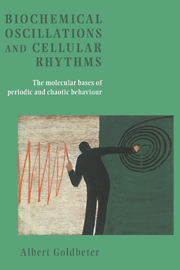Book contents
- Frontmatter
- Contents
- Foreword to the English edition by Michael Berridge
- Foreword to the French edition by Ilya Prigogin
- Preface
- 1 Introduction
- Part I Glycolytic oscillations
- Part II From simple to complex oscillatory behaviour
- Part III Oscillations of cAMP in Dictyostelium cells
- 5 Models for the periodic synthesis and relay of cAMP signals in Dictyostelium discoideum amoebae
- 6 Complex oscillations and chaos in the cAMP signalling system of Dictyostelium
- 7 The onset of cAMP oscillations in Dictyostelium as a model for the ontogenesis of biological rhythms
- Part IV From cAMP signalling in Dictyostelium to pulsatile hormone secretion
- Part V Calcium oscillations
- Part VI The mitotic oscillator
- Part VII Circadian rhythms
- References
- Index
5 - Models for the periodic synthesis and relay of cAMP signals in Dictyostelium discoideum amoebae
Published online by Cambridge University Press: 26 February 2010
- Frontmatter
- Contents
- Foreword to the English edition by Michael Berridge
- Foreword to the French edition by Ilya Prigogin
- Preface
- 1 Introduction
- Part I Glycolytic oscillations
- Part II From simple to complex oscillatory behaviour
- Part III Oscillations of cAMP in Dictyostelium cells
- 5 Models for the periodic synthesis and relay of cAMP signals in Dictyostelium discoideum amoebae
- 6 Complex oscillations and chaos in the cAMP signalling system of Dictyostelium
- 7 The onset of cAMP oscillations in Dictyostelium as a model for the ontogenesis of biological rhythms
- Part IV From cAMP signalling in Dictyostelium to pulsatile hormone secretion
- Part V Calcium oscillations
- Part VI The mitotic oscillator
- Part VII Circadian rhythms
- References
- Index
Summary
The amoeba Dictyostelium discoideum (Raper, 1935) is one of the most studied organisms in developmental biology (Bonner, 1967; Loomis, 1975, 1982). The main reason underlying the attractiveness of these amoebae is twofold. On one hand, they can switch from a unicellular to a multicellular stage during their life cycle (Raper, 1940a,b) by resorting to a chemical mechanism of intercellular communication (Bonner, 1947; Shaffer, 1956, 1962; Devreotes, 1982; Gerisch, 1982, 1987), which presents some similarities with hormonal communications in higher organisms (Newell, 1977). On the other hand, once the multicellular stage is reached, the amoebae differentiate into at least two distinct cell types, thus providing a simple model for the study of pattern formation (Nanjundiah & Saran, 1992) and cell differentiation in eukaryotes (Takeuchi, Noce & Tasaka, 1986; Gross, 1994). Recent advances in the manipulation of the Dictyostelium genome reinforce the importance of this organism in the study of the molecular bases of development.
It is for yet another reason that Dictyostelium amoebae draw our attention here. The mechanism of intercellular communication that governs the transition between the isolated and collective phases of their life cycle possesses a periodic nature (Gerisch, 1968,1971; Shaffer, 1962). After reviewing the experimental facts that make this phenomenon a prototype for biochemical oscillations in cell biology, theoretical models are developed in this chapter to account for this biochemical rhythm. A particularly interesting aspect of the Dictyostelium example, which will be highlighted here, is that it illustrates well the endless feedback between modelling and experimental studies. As the latter progress, sometimes stimulated or guided by the motivation of testing theoretical predictions, alterations to the initial model become necessary.
- Type
- Chapter
- Information
- Biochemical Oscillations and Cellular RhythmsThe Molecular Bases of Periodic and Chaotic Behaviour, pp. 163 - 239Publisher: Cambridge University PressPrint publication year: 1996



